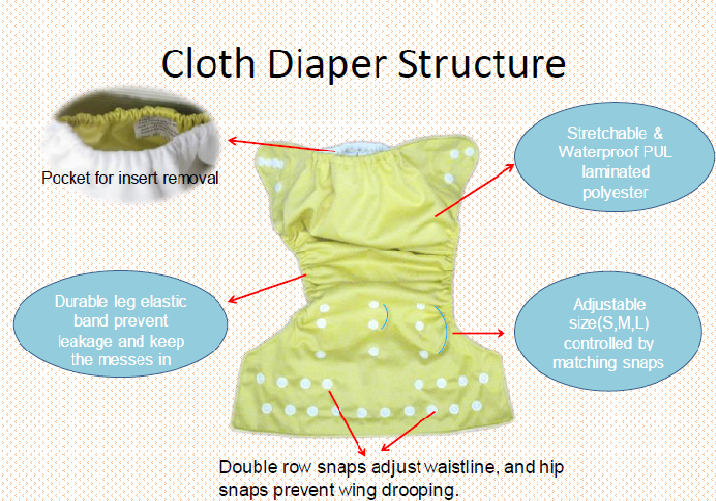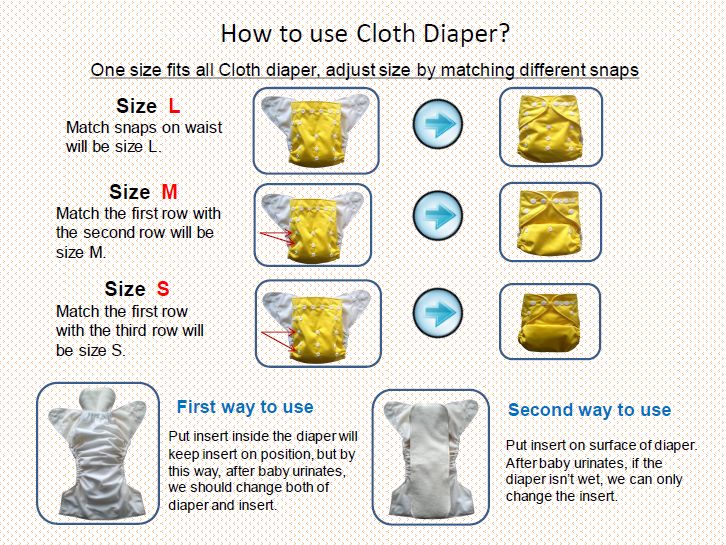Features of the diaper: New Washable Reusable PUL Baby Infant Cloth Pocket Diaper One Size Outer Layer: PUL fabric which is highly water resistant, breathable, and durable. Inner Layer: Very soft stay dry micro fleece cloth, which wicks moisture away from baby’s skins. This is a one size diaper, adjustable with Kam snaps that allow this diaper to be used from approximately 8lbs-36lbs. (This depends on your baby's shape and build) Double row snaps at the hips help prevent wing drop and allow for a snugger fit at the legs.

Here are some very valid points of why you should chose to cloth diaper your little one:
According to some studies, the budget for disposable diapers is estimated at $40 to $80 per month. The number of cloth diapers you will need for 1 child during his first years varies from 20 to 30 depending on how often you will wash them. It will cost if you get 30 diapers, about $240-$335 (depending on which styles you buy from me. I have lots to choose from.) The only extra money you will need to spend is for hot water, electricity and detergent. Therefore you can see easily the savings you can get from using our washable nappies.
How many diapers do you need? Newborn to 4 months -- 20~30 diapers Infant (4 to 10 months) -- 20~25 diapers Toddler (over 10 months) -- 15~20 diapers (It also depends on how often you do laundry.) I wash a load of diapers a day.
Protect environment: At a first glance the use of water to wash reusable nappies may appear as a bad point. Nevertheless, taking into consideration the following estimates you will probably agree that disposable diapers are much more harmful to the environment than cloth diapers. In the US only the manufacturing process of disposable diapers require the usage of tons of water. It also requires the usage of tons of plastic hundreds of thousands of trees. Although some disposables are said to be biodegradable; in order for these diapers to decompose, they must be exposed to air (oxygen) and sun. Since this is highly unlikely, it can take several hundred years for the decomposition of disposables to take place, with some of the plastic material never decomposing.
You can also save these diapers, and use them if you have another baby, or give them away to family or friends when you are done. I can't tell you how much money I have saved personally by doing cloth diapers, and I have another one on the way, so no extra in diaper costs.

How to Use: 1. Wash before first use. Usually it will take a few washes to reach its full absorbency (could be 6 washes or more). VERY IMPORTANT!!! 2. Place the insert inside the nappy through the open pocket in the back, or lay insert in diaper. 3. Liquid will be absorbed through the inner layer of the nappy to the insert. 4. More than one insert may be needed when sleeping or when necessary. 5. Nappy should be changed every 2-3 hours, and when damp, to prevent nappy rash.
Most leakage caused by improper insert stuffing and sizing. When stuffing the inserts into pocket, make sure it is not crumpled and both edges of the insert reach the sides of the legs. As for sizing, this is not exact as each child may have different waist and leg girths. As a guideline 8-16 lbs babies should be in the small setting, 17 to 23 lbs babies in medium setting, and 24+ lbs babies in large. Again, make your own judgement. You want no gaps around the legs and the diaper should be snug but not leaving any elastic red marks on your child because it is too tight. Make sure that the insert is all the way tucked in the diaper, that will also prevent leaks.
How to wash 1. Please wash the diaper and insert at first before using it. 2. Remove and rinse off the residuals (knock solids into toilet), then store in dry pail 3. Machine wash warm (no hotter than 35oC), cold rinse 4. Hang them up to dry in the sun** (sunlight helps bleach the nappies to remove any remaining stains), or "Low" tumble dry 5. Do not store nappies for too many days, should be washed in 1-2 days 6. No bleach, no softener**
Soaking method: Neutral detergent in the cold water, Do not use bleach, it will damage diapers. Washing method: Using detergent in warm water washing (under 30'C), rinse clean, avoid soap residue causing nappy rash. **Do not use Fabric Softener, otherwise, that will reduce the absorbancy of diapers. **Hang out to dry will be best, or in low temperature drying in the dryer.
Proper Changing: Newborns wet their diapers often because they have very tiny bladders, so you will require diaper change in every 1-2 hours. I recommend to change the insert when it wet when they are older, so it will help keep the baby leak free. Frequent leakage may be related to insufficient changing.
Trouble Shooting Leaks Through the Diaper: Some infants urinate frequently and are heavy soilers. It is possible that a large amount of urine at one time will cause leakage through the diaper. Baby boys most often require thicker lining in the front, as fluid tends to flow upward. Make sure not to cover the tummy or navel (or umbilicus). Baby girls often need extra padding at the back. This can slow down the urine stream so that the diaper has a chance to absorb properly. Using 2 inserts will usually resolve it but if your child has an extremely strong urine stream fold one of 2 to inserts in half to create a triple layer to slow down the stream. Place the insert accordingly for a boy or girl.
Trouble Shooting Leaks Around The Legs: Make sure none of the inner fabric around the legs can be seen from the outside. Even the slightest bit of diaper fabric sticking outside of the cover can cause a surprising amount of leakage to occur quickly.
I DO COMBINE SHIPPING IF YOU BUY MULTIPLE ITEMS FROM ME!!! Just ask me for an invoice when you buy the diapers, so I can give you the best price. If you pay without waiting for an invoice, then I can't give you the combine shipping. PLEASE if you have any questions, let me know.
Shipping is as follows for multiple diapers. For 2 diapers, it is $4.59. For 3 it is $6.95. For 4-6 diapers it is $9.49. For 7-10 it is $12.95. For 11-15 it is $15.49, and for 16 to 25 it is $19.95. Please let me know if you need more. I'll calculate shipping.
I do offer returns on items with defects only, since this is a new item. I offer a 14 day money back guarantee. If you do return the item, you as the buyer must pay the return postage. Again, I only accept returns if the item is defective. I have checked each diaper, so I will handle the returns as such. THANKS SO MUCH FOR LOOKING, AND HAVE A GREAT DAY!!! CHECK OUT MY OTHER DIAPER LISTINGS FOR OTHER CUTE STYLES!!!!